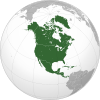|
Geography of Montserrat
 Montserrat is an island in the Caribbean Sea, in the Leeward Islands. Its nearest neighbours in the island chain include Guadeloupe to the southeast, Antigua to the north-east and Nevis to the northwest. The island is 16 km (9.9 mi) long and 11 km (6.8 mi) wide, with a coastline of about 40 km. The island is volcanic and largely mountainous. The Soufrière Hills volcano became active in 1995, causing widespread devastation, including the destruction of the capital and formerly largest settlement on the island, Plymouth. The southern part of the island is now uninhabitable and human settlement is constrained to the north. Montserrat has two islets, Little Redonda and Virgin, as well as Statue Rock. ClimateMontserrat has a tropical climate, with little daily or seasonal temperature variation.
StatisticsLocation: About 500 km southeast of Puerto Rico Maritime claims:
Terrain: Volcanic islands, mostly mountainous, with small coastal lowland Elevation extremes:
Natural resources: Negligible Land use:
Natural hazards: Severe hurricanes (June to November); volcanic eruptions Environment - current issues: Land erosion occurs on slopes that have been cleared for cultivation.[3] References
Sources
|
||||||||||||||||||||||||||||||||||||||||||||||||||||||||||||||||||||||||||||||||||||||||||||||||||||||||||||||||||||||||||||||||||||||||||||||||||||||


